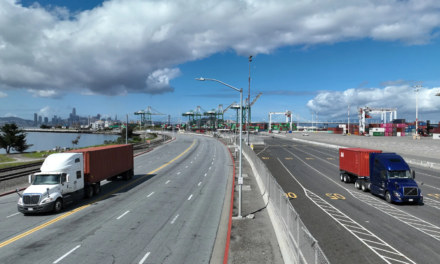
Industry experts are unanimous in their assessment that trucking conditions and rates are reaching their lowest point, leading to speculation on when an upward trend can be expected. Analysts have noted a decline in freight volumes from March to April, with the difference in the number of business days as one potential contributing factor. However, the calendar discrepancy does not account for the year-over-year declines witnessed since April 2022.
According to May 10, 2023, release from DAT Freight and Analytics, dry van freight saw a decline of 15.5% from March and 12.3% from April 2022. Temperature-controlled freight experienced a more pronounced drop of 16.3% from March and 12.5% from April 2022. Flatbed freight declined by 13.7% but remained 3.5% higher than the previous April (attributed to its correlation with government infrastructure initiatives).
The DAT report highlights that dry van and temperature-controlled freight hit their lowest levels since February 2021, when severe winter weather and a polar vortex caused significant disruption to freight movement. Ken Adamo, Chief of Analytics at DAT, emphasizes the pivotal nature of May for shippers, brokers, and carriers as the effects of seasonality on freight volumes and rates become more apparent. The sustainability of these effects, however, remains uncertain.
The report from DAT also indicates a decrease in load-to-truck ratios across all three trailer categories, resulting in heightened competition for available loads and consequent downward pressure on rates. As a result, all three categories experienced lower rates, with average dry van spot rates falling 10 cents below March rates and 71 cents per mile below April 2022. Temperature-controlled freight showed similar reductions, while flatbed spot rates dropped by 4 cents and were 70 cents per mile lower than in April 2022.
Adamo highlights that for rates to increase, two factors are crucial: a reduction in the number of trucks and an increase in freight volume. Carriers are beginning to address the first factor by reducing truck orders and closing their operations. As the construction season ramps up and produce harvesting begins, there is a potential for increased freight volume. However, market dampeners such as inflation and higher interest rates could continue to impact the industry.
In another report, ACT Research’s Freight Forecast on May 16 addresses the impact of carrier closings. It reveals a record rate of contraction in interstate operating authorities, with approximately 11,000 net revocations since last October, including 1,600 net revocations in April alone. Tim Denoyer, ACT’s Vice President and Senior Analyst, suggests that this tightening of capacity will aid in stabilizing spot rates and initiating an upward trajectory.
Denoyer also notes that grants of new authority and reinstatements of carriers whose authority lapsed are higher than usual, indicating an overall decline in the number of carriers. Long-distance trucking employment is also contracting, with an 8,700-job decline in Q1’23, or 1%. Although long-haul jobs still show a 3% year-over-year increase in the latest March data point, they are expected to decline by June.
According to ACT President and Senior Analyst Kenny Vieth, a shallow recession, centered on mid-year, is still expected to materialize. However, David Spencer, Vice President of Market Intelligence for Arrive Logistics, points out that job growth in the trucking sector continues to defy expectations despite the declining rate environment. The growth is likely driven by owner-operators transitioning to company jobs and increasing truckload demand in sectors such as non-single-family housing construction and oil and gas drilling.
The Cass Freight Index for Shipments, measuring freight levels across various transportation modes, witnessed a 1% decline from March and a 2.4% drop from April 2022. Meanwhile, the Cass index for freight expenditures experienced a more substantial decline due to the ongoing downward trajectory of record-high freight rates. The Index showed a 2.1% decline in March expenditures and a 14% drop from April 2022.
The Cass release, however, suggests optimism regarding freight availability and rates in the upcoming months. While forecast prediction numbers are typically reserved for paid subscribers, the release notes that the U.S. freight transportation industry is on the verge of transitioning from the bottoming phase into the early phase of the freight cycle, following a prolonged period of softness.
The “cycled refers to the Truckload Cycle or Capacity Cycle, which the trucking industry consistently follows. The principle is simple: as carriers earn profits, they invest in buying more trucks to take advantage of high freight rates. However, as the number of available trucks increases, competition for loads intensifies, resulting in lower rates. This downward trend continues until enough trucks exit the market, leading to a balance.
With trucks and drivers leaving the market, rates have likely reached their lowest point. However, the possibility of a recession could pose challenges. Eventually, as freight levels rise, rates will respond by increasing, leading carriers to invest in more trucks. The timeframe for this transition varies depending on experts, ranging from now to six to eight months from today. Until then, truckers should focus on minimizing expenses and carefully selecting the loads they haul.
Other Articles

Fuel Tanker Erupts in Fire on I-14 near Nolanville, Texas, Resulting in Driver’s Death
NOLANVILLE, Texas - A section of the westbound Interstate 14, located southwest of Waco, Texas, will remain closed for the rest of the day following a fiery multi-vehicle accident involving an 18-wheeler transporting gasoline. According to authorities, the truck...

Revolutionizing Green Transport: Nikola’s Hydrogen Fueling Innovation
In the dynamic world of alternative fuel transportation, Nikola, a pioneering heavy-duty truck manufacturer, has recently unveiled its first HYLA-branded hydrogen refueling station. This strategic move marks a significant leap in hydrogen fueling innovation,...

Breaking News: The MOVE Act Set to Transform State Authority on Truck Weight Limits Amid Rising Freight Congestion
Tackling Freight Congestion with the MOVE Act In an unprecedented move, the Modernizing Operations for Vehicles in Emergencies (MOVE) Act emerges as a game-changing proposal in the logistics and transportation sector. Aimed at combating freight congestion, this bill...










